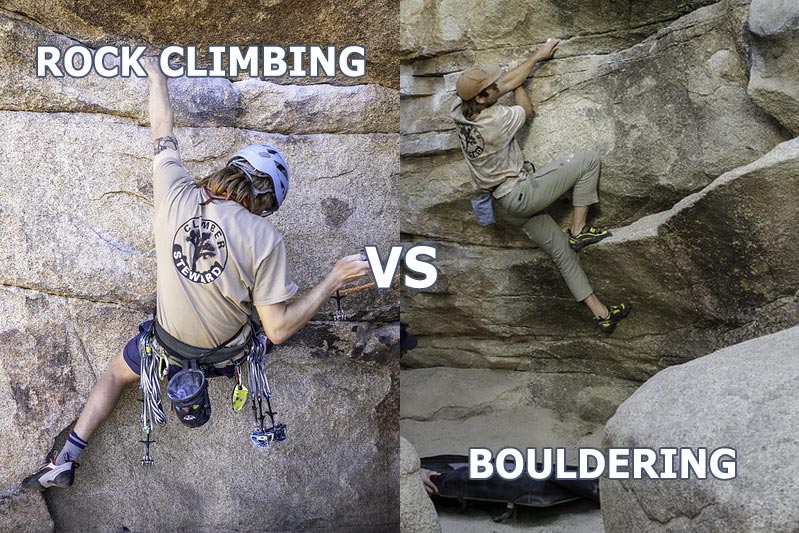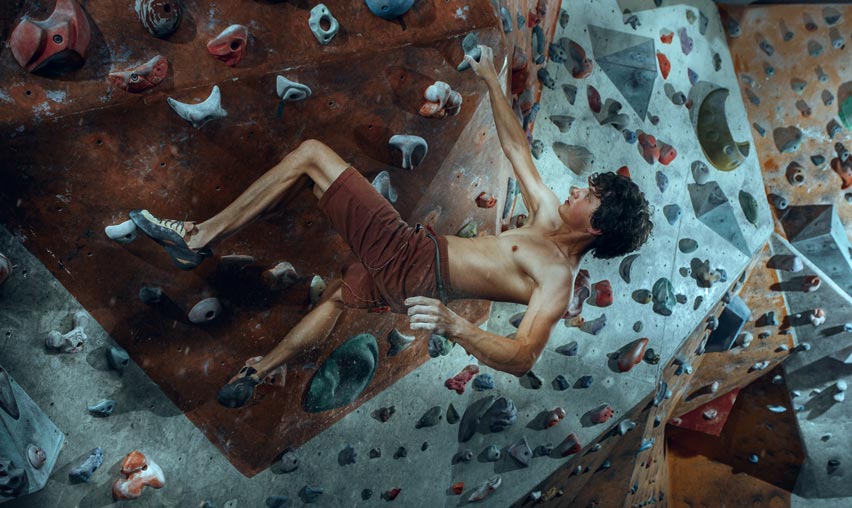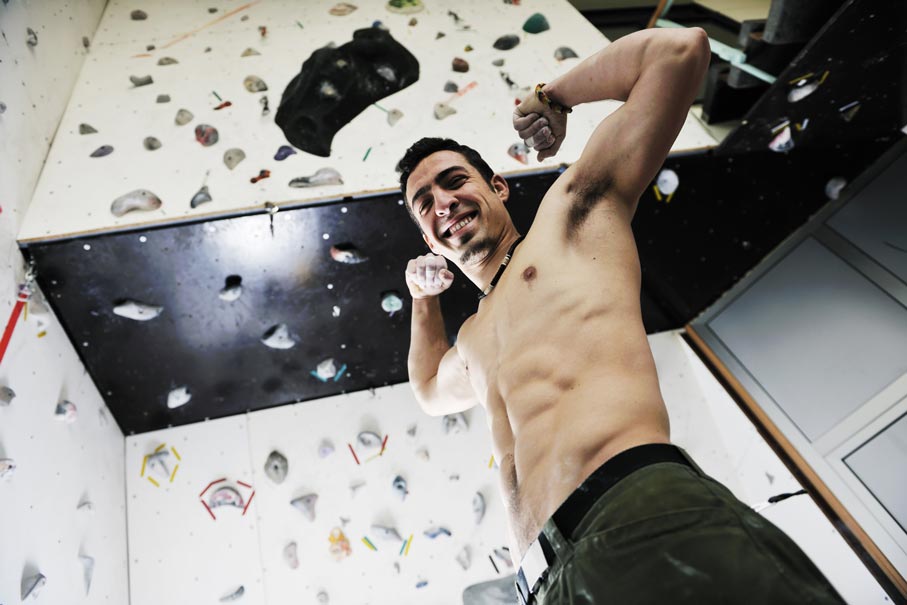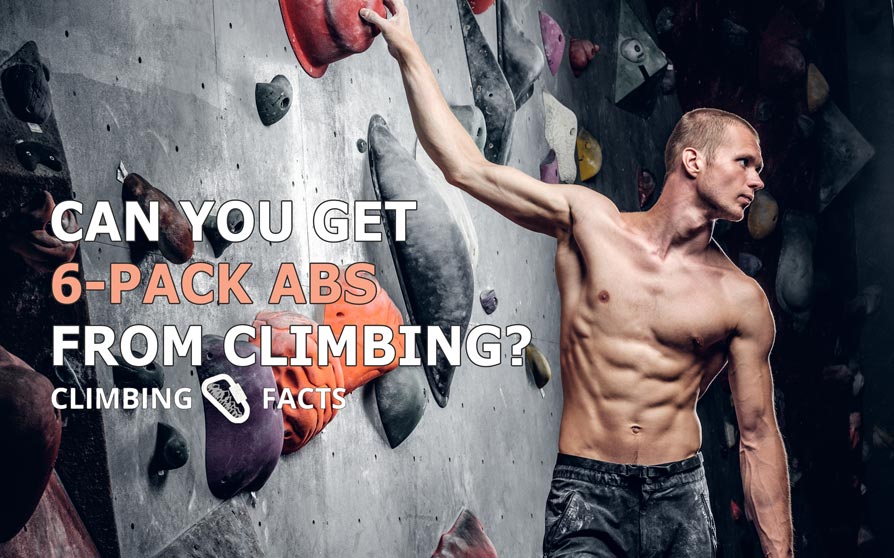Rock Climbing is a full-body workout that targets just about every muscle. So naturally, you will gain abs from climbing if you practice the sport long enough.
But that’s probably not what you came to this article for. Of course, you knew that climbing targets the core muscles, and practicing rock climbing would eventually lead to visible abs. You are likely more interested in when you will start seeing abs as a result of your climbing training. Or when you will start feeling those gains in your abdominal muscles.
The answer to that question is not so simple either as visibility will depend upon your diet and current body fat. A climber who has started the sport with an already lower body fat percentage is much more likely to see visible ab gain than someone who starts at a higher amount. Additionally, a climber who maintains a healthy diet is going to see gains much faster than someone who eats fast food twice a week.
Which style of climbing stimulates abdominal growth?
There are many different styles of climbing. Bouldering and sport climbing are the most popular so we’ll stick to those for now. These two styles both target the core but in different ways.

Bouldering requires a lot of power and explosive movements which demand a lot of engagement from the abs and other core muscles. This makes bouldering a phenomenal core-building activity.
Sport climbing requires a lot of endurance as the routes are much longer. On these long routes, sport climbers use core engagement to maintain body position and support themselves during ascents. Because this activity is so endurance-focused, sport climbing is much better for building overall fitness as opposed to bouldering which is more strength focussed.
While both are great at targeting the abdominal muscles, sport climbing is the clear winner here. Sport climbing is superior at fat-burning as the climber spends much more time on the wall. This is also why sport climbers look lean (sometimes mistaken for skinny) and boulderers tend to look bulkier.
So naturally, one is going to see abdominal growth faster when sport climbing as opposed to when they take up bouldering. Not because one targets the core muscles better than the other, but because one is better at burning fat which in turn will make those abs more visible.
Which climbing terrain targets the core the most?
The level of core engagement a climber uses will depend on which type of terrain they are climbing on. Overhung terrain requires the most core engagement while slab and vertical climbs require much less core activity.

Lack of core strength is actually the primary reason why so many climbers struggle with overhung terrain. Many climbers, especially beginner climbers, have a harder time on overhangs than on other types of terrain. Oftentimes beginners climb at least a grade lower in overhang than they do on slabs or vertical.
This is because most of us have enough upper and lower-body strength to take on easy climbs on vertical and slab walls but lack core strength to take on the same grades in an overhang where our core does most of the heavy lifting.
Furthermore, this leads to beginners avoiding overhung terrain altogether. But this will not only stunt your growth as a climber, but it will also lead to fewer core gains from climbing.
So if you want to gain those 6-pack abs from climbing, you will have to incorporate a lot of overhang climbing into your training. This means you will likely have to climb below your grade, which is completely fine!
If you are struggling with overhang climbing, you might want to consider adding additional (at home) core workouts to your training.
climbing movements that build the core
Here are some movements that actively require use of your abdominal muscles. You can incorporate these into your climbing training if you wish to further train your core.
Dynamic movements
A dynamic move refers to any type of move that uses explosive momentum to get to the next hold. For example, deadpoints and dynos are dynamic movements. Dynamic movements are often necessary when the hold is reachable through static movement.
Dynamic movements are especially common among short climbers who have less reach and thus need to frequently make big lunges to get to the next hold. These dynamic moves require the core to maintain stability and balance while making the lunge.
any move during steep climbs
As mentioned earlier, climbers have to continuously use their core to make moves during overhung terrain. So if you wish to incorporate more core-active movements during your climbing sessions, stop avoiding the cave, roof and other overhung parts of the bouldering or sport climbing gym!
Toe hooking & heel hooking
Both toe and heel hooking are climbing movements that require an active core to maintain body tension. These movements will not only work your core, they will also make you a much better climber. Finding heel hooks to pull yourself up from can really change how you climb at your limit. Similarly, a good toe hook will help you maintain stability on the worst holds imaginable.
So next time you fall off because the hold is too slopey, or next time you feel like you can’t reach a far-away hold, see if you can incorporate a toe hook or heel hook to send the problem.
Will you get a 6-pack from Rock climbing?

Rock climbing is a physically demanding sport that works the core muscles really well. So in theory, you should be able to get six-pack abs from climbing. However, rock climbing alone may not be enough for you to have visible abs depending on your diet and the level of climbing you are at.
If you aren’t noticing results, it is likely because your body fat percentage isn’t low enough to have visible abs. In this case, you may have to change your diet and perform more aerobic excercice to get the expected results.
Additionally, you may not be at the right level of climbing to achieve six-pack abs. Most beginner climbing routes and bouldering problems do not require all that much core activity. Especially when these routes are not overhung. So if you want to achieve six-pack abs, you will have to progress into higher levels of climbing and focus on climbing more overhung terrain.
Furthermore, time is also a constraint. Six-pack abs are not going to appear within just a few weeks or months of climbing. These muscles take time to grow. Lower your expectation and keep climbing, eventually, you will get those washboard abs that you desire.
Finally, if you really want to get 6-pack abs you can accelerate the process by adding at-home climbing workouts to your training schedule. This will not only grow your core but will also boost your climbing. A WIN-WIN!
ab workouts on top of climbing will accelerate your progress

While climbing definitely works the abdominal muscles and stimulates core growth, to get the most out of your climbing training you should combine it with additional ab workouts. This is what I started doing during my own climbing journey and it showed much faster results than using just climbing as my own source of core-training.
Additionally, at-home ab training will make you a better climber. Especially if your core tends to hold you back (e.g. you struggle on steep terrain). So there is no reason not to do them! You can work your abs daily, or try a 3-day per week schedule to start off with.
I do believe you can get abs from solely climbing training, but it will take much longer. If you want to accelerate the progress, combine your climbing sessions with at-home ab workouts.
Furthermore, if you want visible abs, you will likely have to burn some fat. Therefore, you should combine your training with aerobics. Cardio is the best way to burn fat around the belly area to make your abs visible.
HITT (High-Intensity Interval Training) is effective at both cardio and core-strength training in one.
👉 Read also: core workout for climbers
Ab workouts for visible abs
10-minute follow-along with Emil Abrahamsson & Matilda söderlund
If you are looking for a daily ab workout featuring climbers, I’m particularly a fan of Emil and Matilda’s workout. This 10-minute workout is very intensive and has three levels of difficulty. I dare you to get to level 3 for each exercise (and beat Matilda at the final exercise, good luck).
This is a good core-building workout but the exercises don’t necessarily translate to climbing.
20-minute ABS & HITT workout with Chloe Ting
Chloe Ting is a massive fitness YouTuber known for her at-home workouts. She was a wide range of core & HITT workouts on her channel so if you are looking for a workout that targets both the core and burns some belly fat, this is the place to go!
Core training for climbers with Hoopers Beta
If you are looking for a core workout that will translate to climbing, Hooper has the workout for you. This may not get you those 6-pack abs as quickly as Chloe Ting’s videos but they will make you a better climber. Within this playlist, hooper has a beginner, intermediate, and advanced climbing workout. Good luck!
My personal journey: how I gained abs from climbing
I had an unfair advantage when I started taking up climbing as a new sport. I have always had a fast metabolism resulting in a low body-fat percentage regardless of my diet. I wouldn’t say my current diet is unhealthy by any means, but I would definitely have to put in more effort if I didn’t have a fast metabolism.
When I first started climbing, I wasn’t practicing any type of sport. I’ve always had desk jobs so my daily levels of fitness were next to nothing. I didn’t really have abs, but I was skinny enough that there was something to see if I flexed hard enough.
Once I started taking up climbing, I first started seeing results after about 6 months of climbing. At this point, the growth in my core was pretty obvious. I could see 4 abdominal muscles poking through regardless of flexing. It had to be in good lighting, so they weren’t ‘rock-hard abs’ by any means, but there were definitely gains.
At this point, I was mostly bouldering and favored overhang terrain. I think my fondness for overhung terrain definitely had some part to play in my gains. I don’t think sport climbing would have made any difference for me as my body fat percentage was low enough that I didn’t need to burn any fat.
After 6-months, I started incorporating daily core workouts into my climbing training schedule. And this accelerated the abdominal growth even more. My 1 year climbing anniversary was just in time for the summer and at this point, nobody could say I didn’t have abs.
So yes, it is possible to get a 6-pack from just climbing within one year. But again, I was unfairly advantaged. I didn’t have to diet or do additional cardio exercises to achieve my washboard abs. Everyones body type is different. You may see faster growth, or much slower.
Don’t compare yourself to the next person and focus on your own journey. If abs are something you desperately want, you will achieve over time. As long as you work hard towards getting them.
More articles like this
- Core workout for climbers
- Tips for short climbers
- Bouldering vs rock climbing
- How often you should go bouldering per week
- Why bouldering is a good full-body workout
- Climbing 101: what is cutting feet?
- How long does it take to progress in bouldering?
- How much does it cost to start bouldering?
- What to wear indoor bouldering
- How much of a bouldering wall can you use?
- Should climbing shoes hurt?
- How many climbing shoes do you really need?
